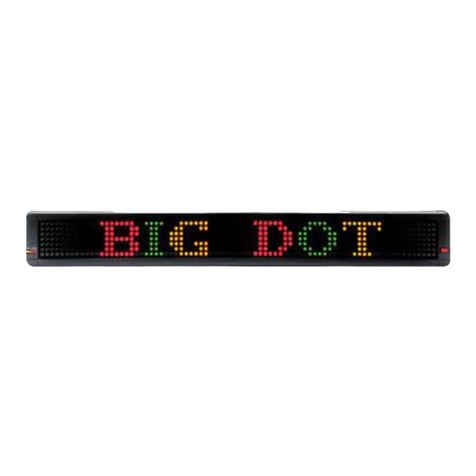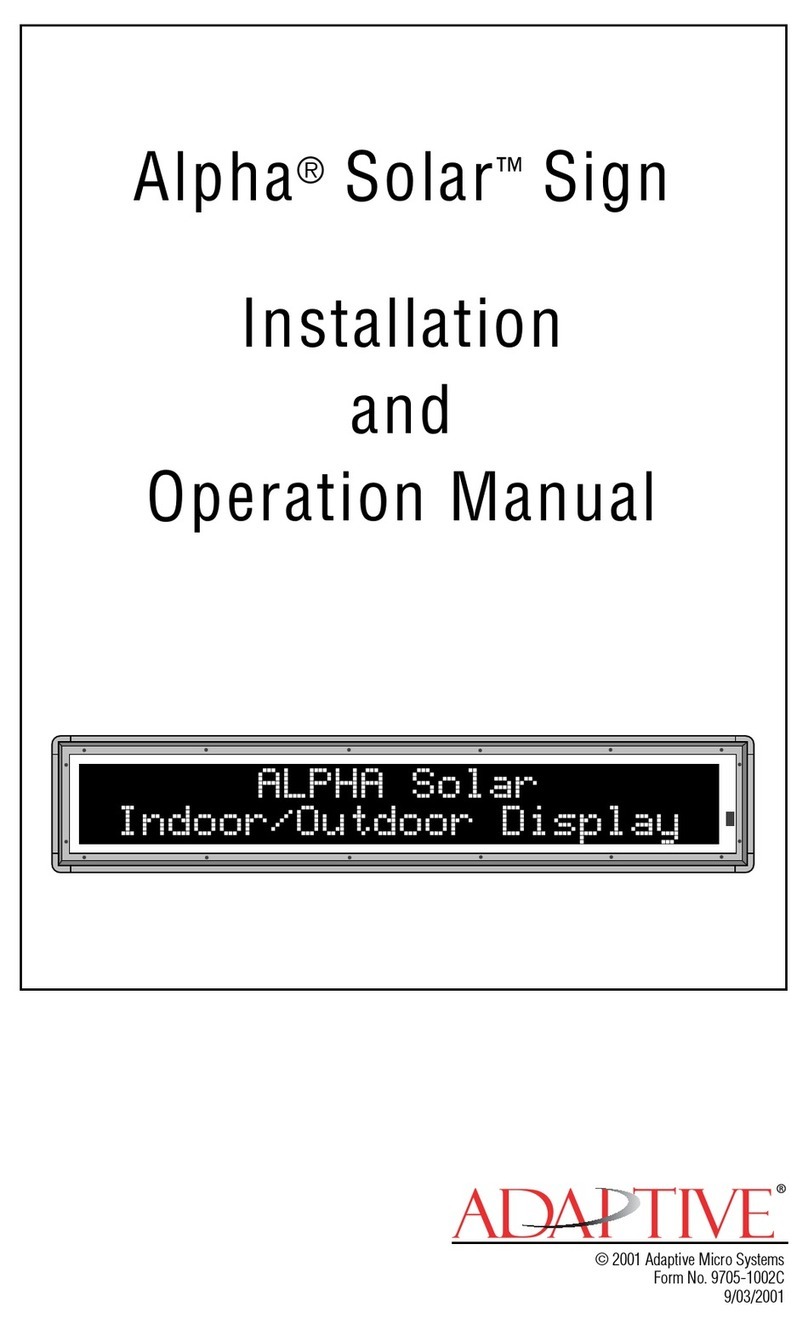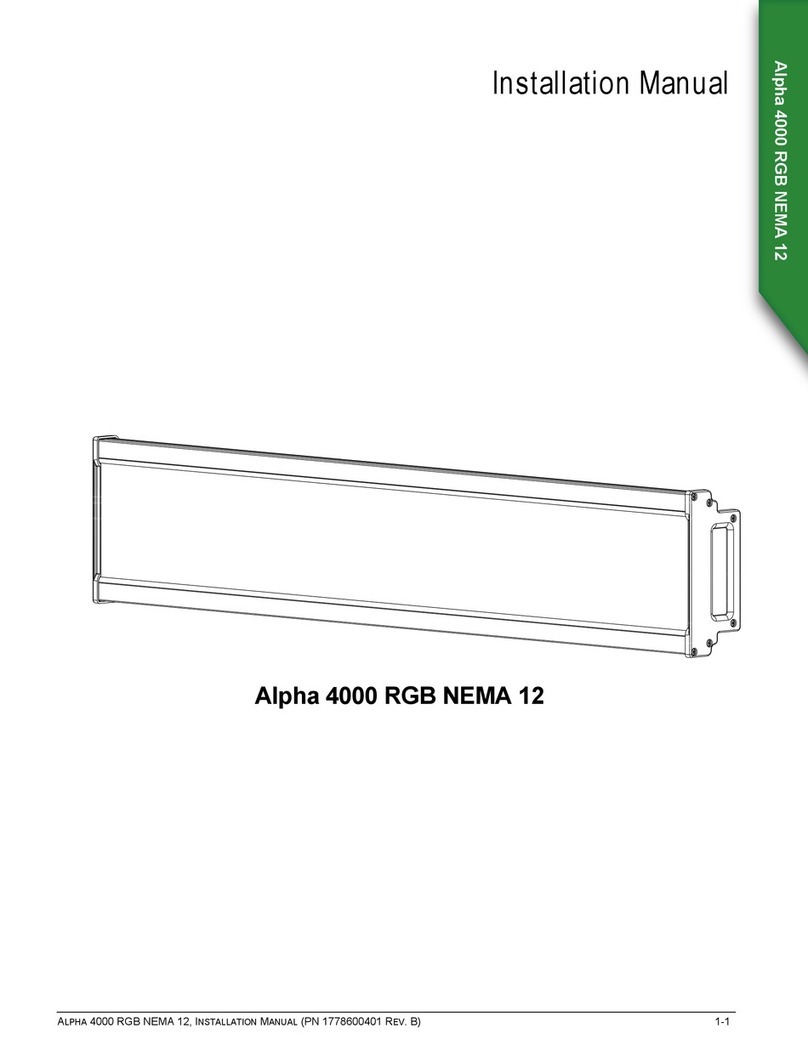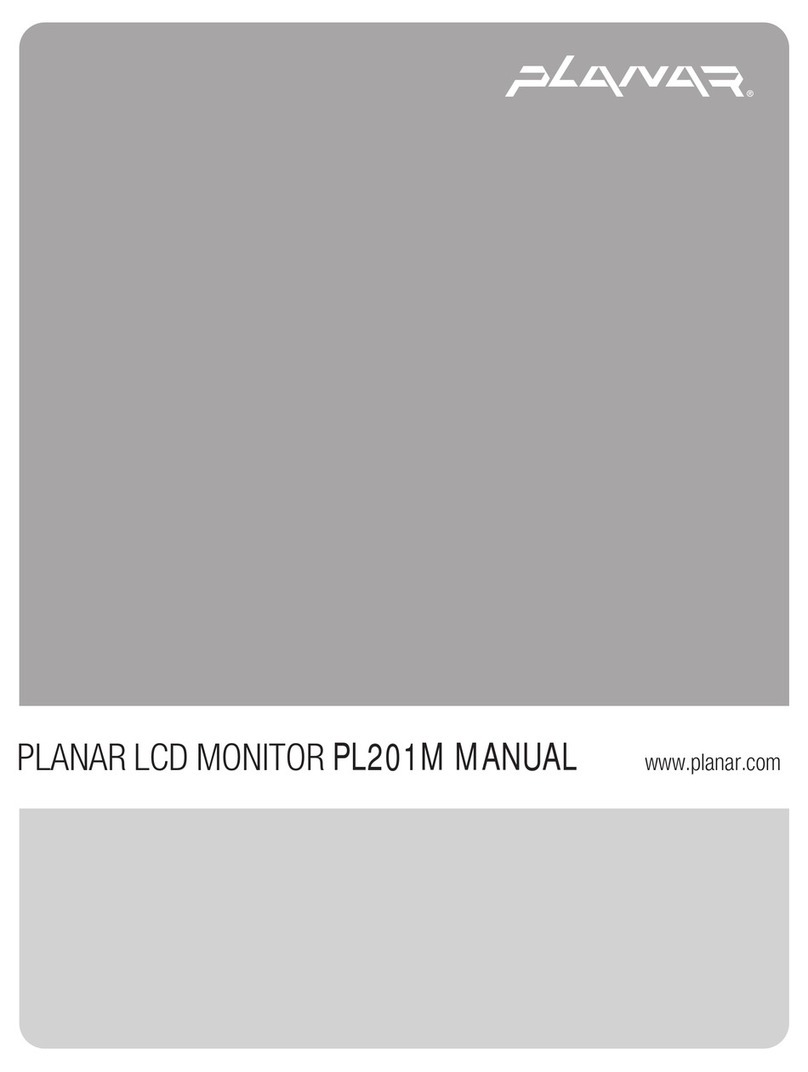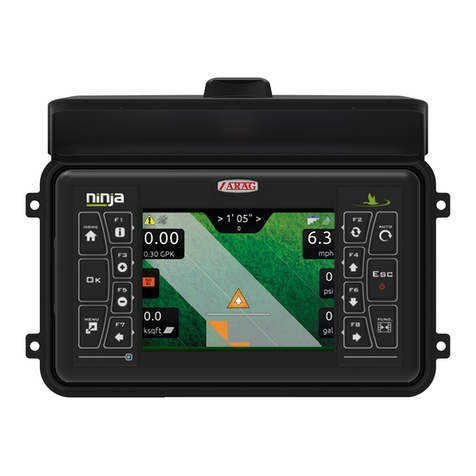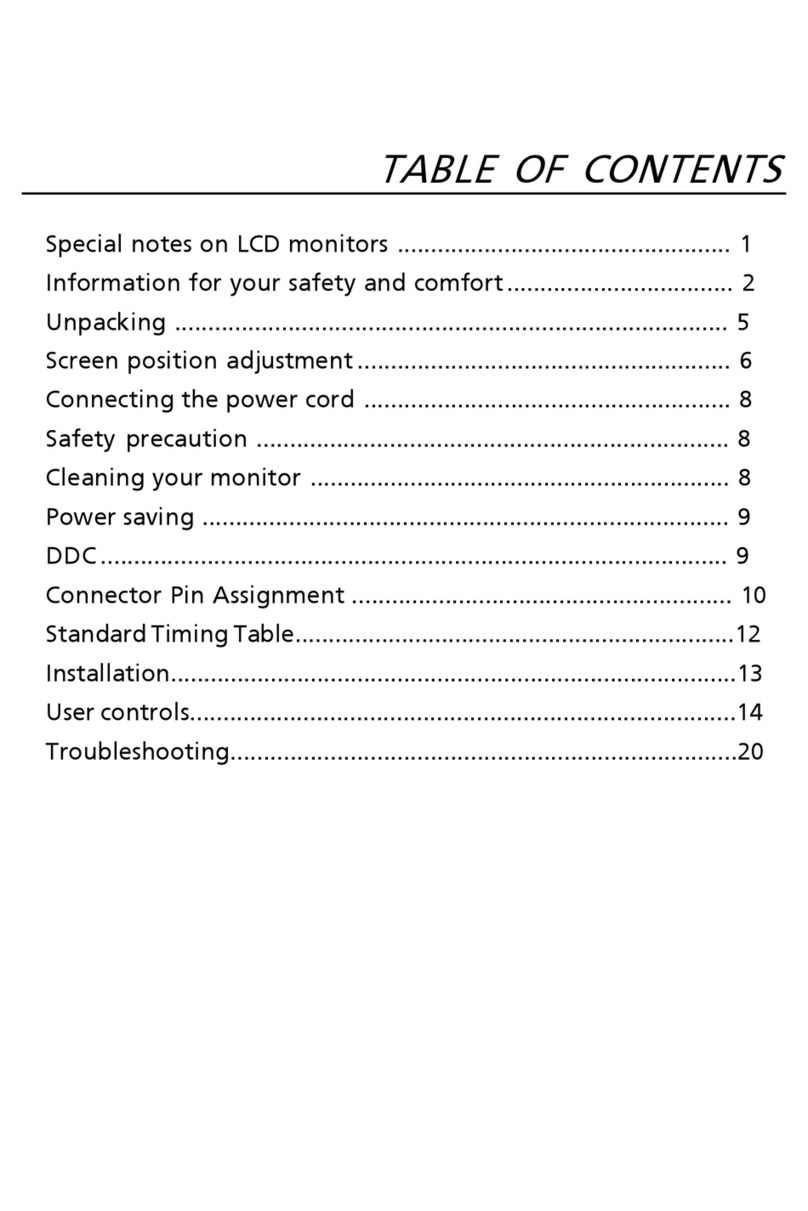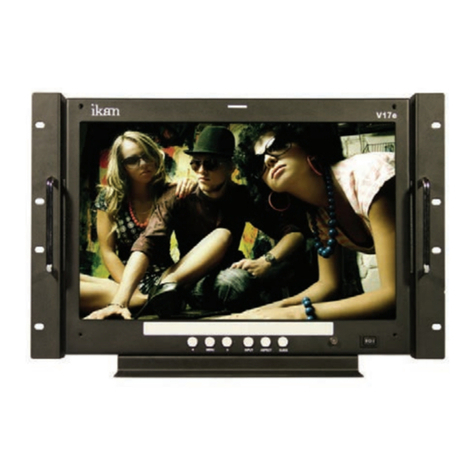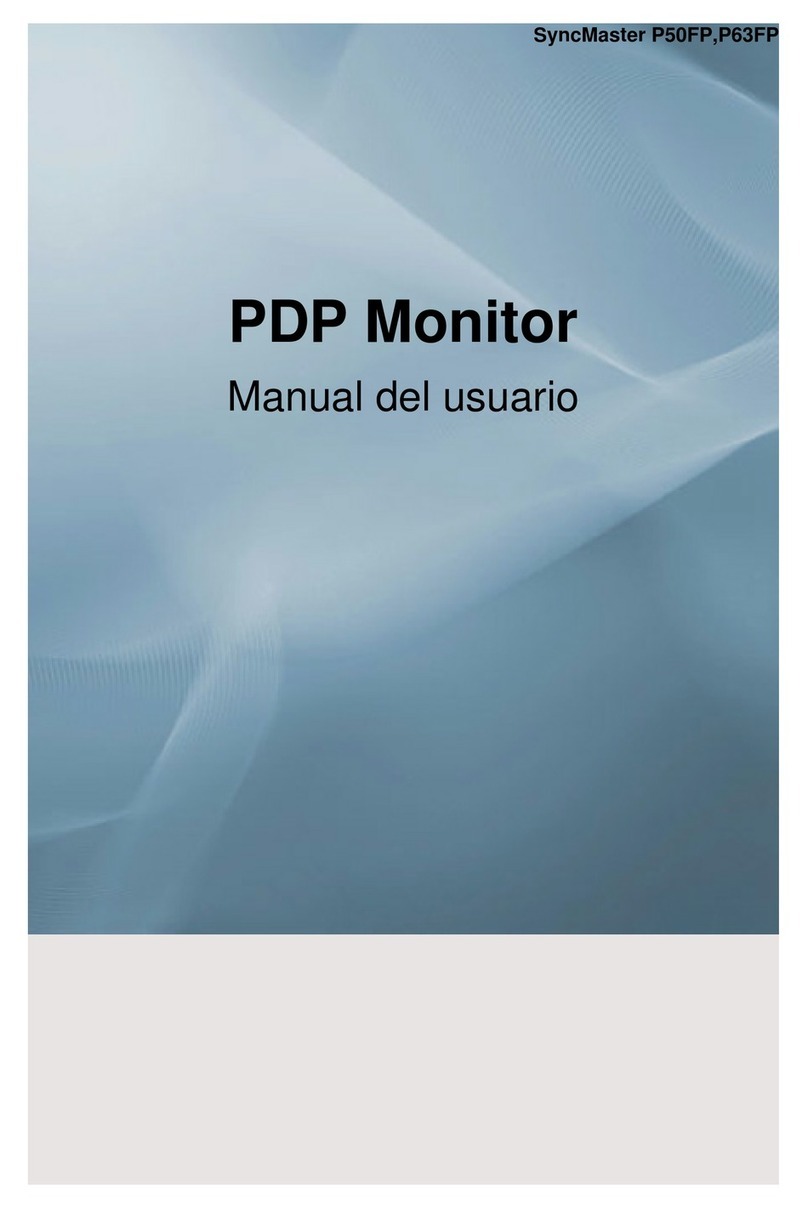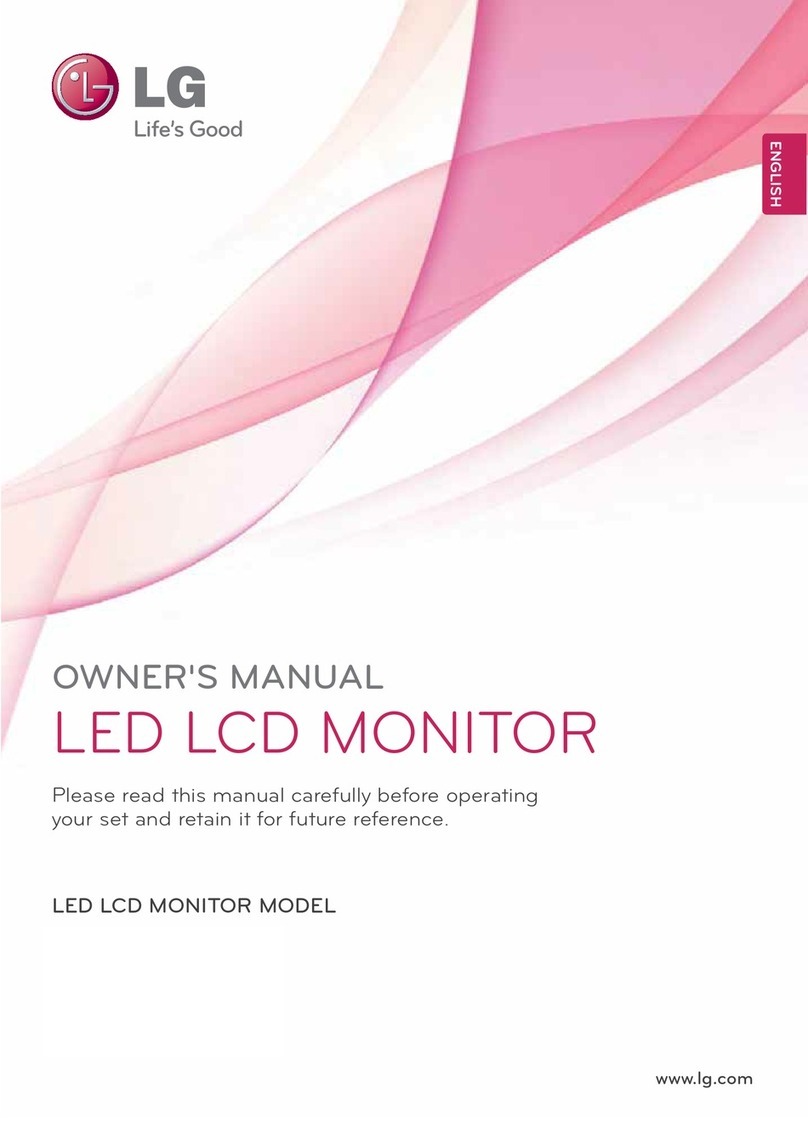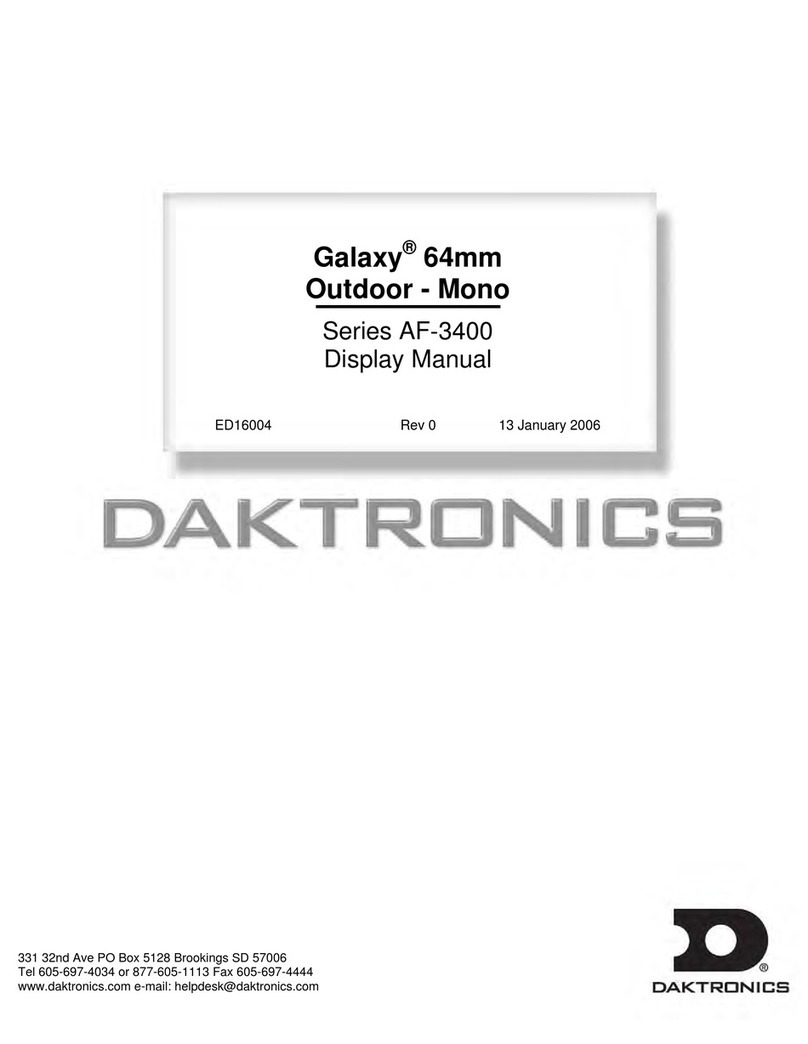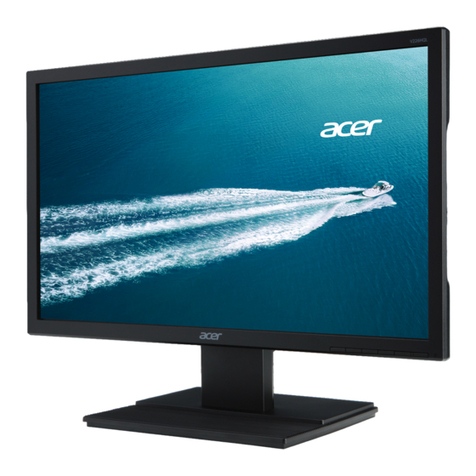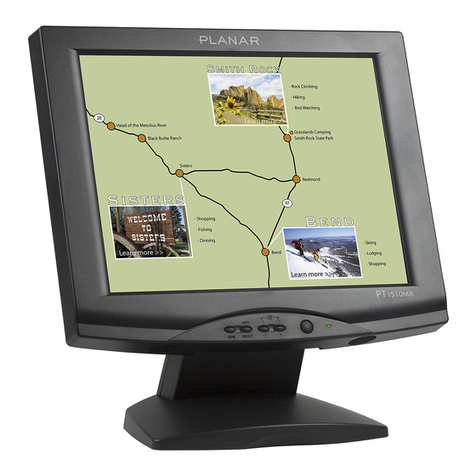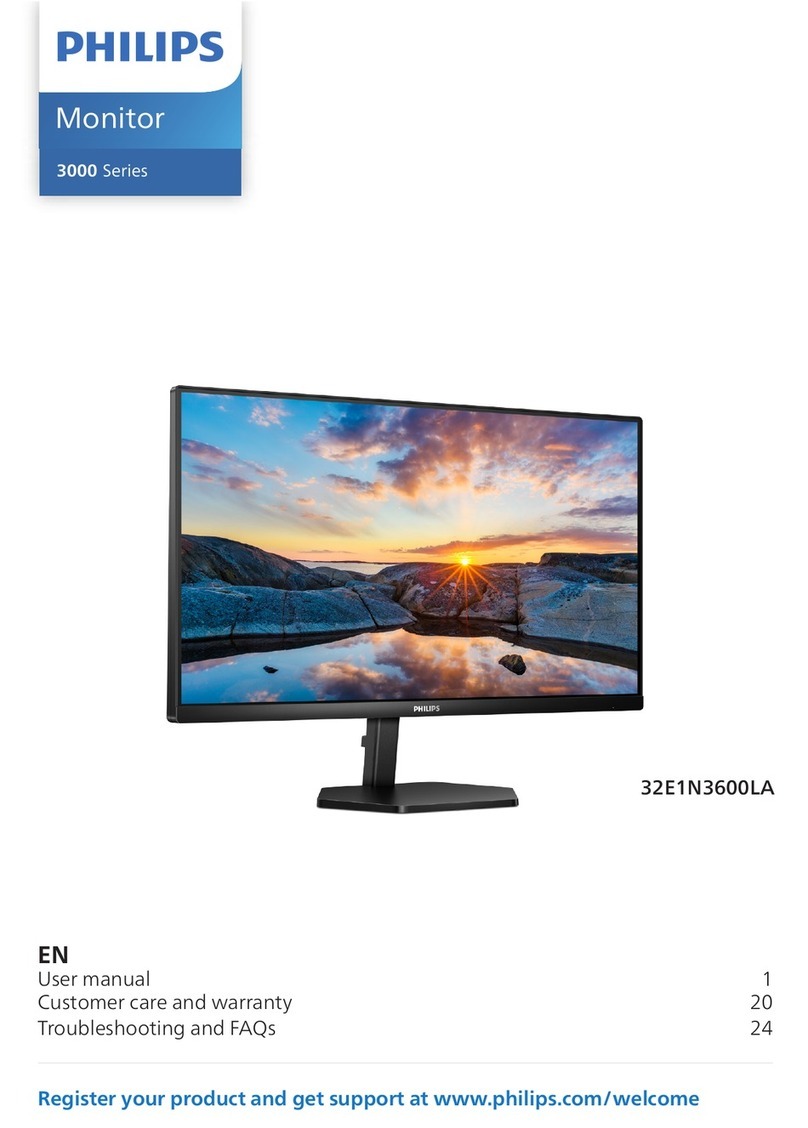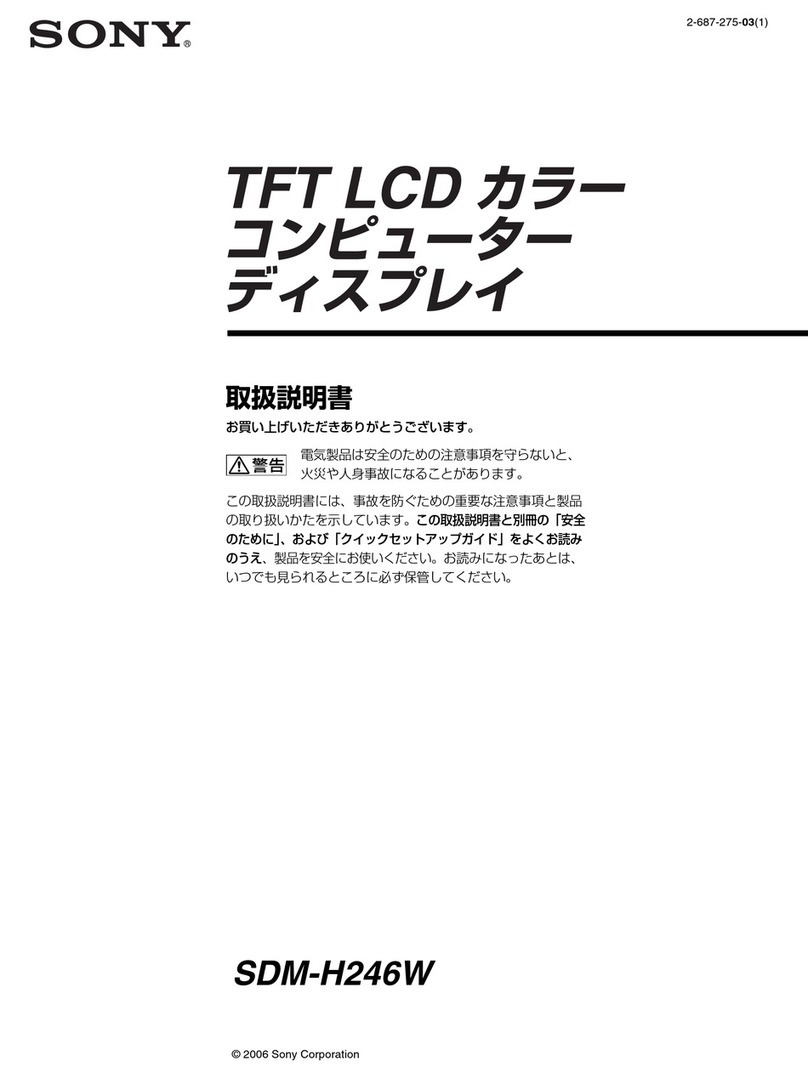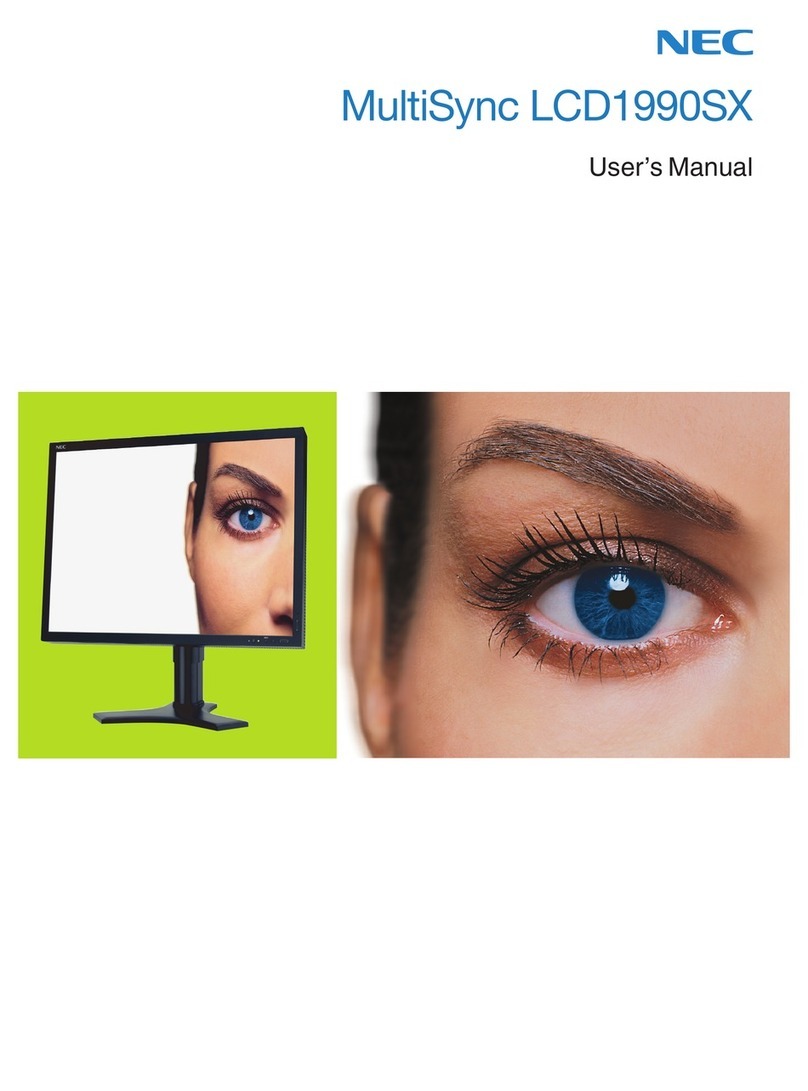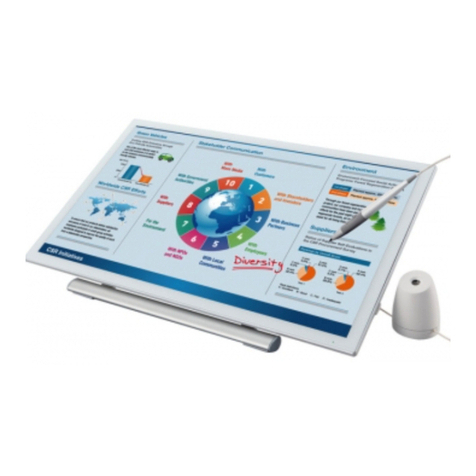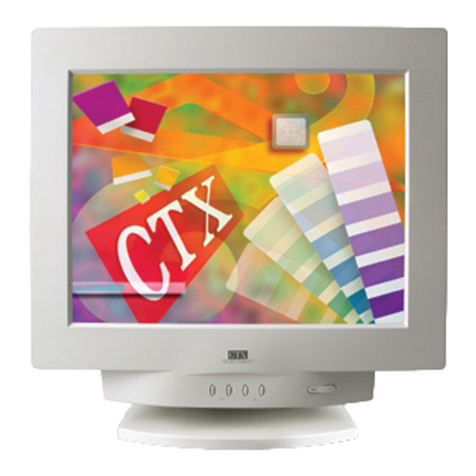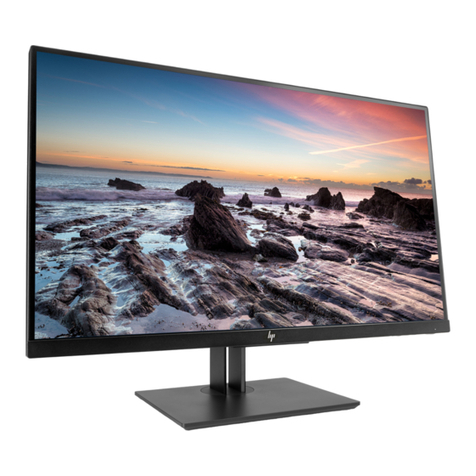Adaptive Micro Systems AlphaEclipse 3600 A Series User manual

© Copyright 2003-2004 Adaptive Micro Systems LLC. All rights reserved.
Adaptive Micro Systems • 7840 North 86th Street • Milwaukee, WI 53224 USA • 414-357-2020 • 414-357-2029 (fax) • http://www.adaptivedisplays.com
Trademarked names appear throughout this document. Rather than list the names and entities that own the trademarks or insert a trademark symbol with each mention of the trademarked
name, the publisher states that it is using names for editorial purposes and to the benefit of the trademark owner with no intention of improperly using the trademark.
The following are trademarks of Adaptive Micro Systems: Adaptive, Alpha, AlphaLert, AlphaNET, AlphaNet plus, AlphaEclipse, AlphaPremiere, AlphaTicker, AlphaVision, AlphaVision
InfoTracker, Automode, BetaBrite, BetaBrite Director, BetaBrite Messaging Software, Big Dot, Director, EZ KEY II, EZ95, PagerNET, PPD, PrintPak, Serial Clock, Smart Alec, Solar, TimeNet.
The distinctive trade dress of this product is a trademark claimed by Adaptive Micro Systems LLC.
Due to continuing product innovation, specifications in this manual are subject to change without notice.
September 28, 2004 9711-8001C
AlphaEclipse 3600 Series A Sign
Installation Instructions
(For the most recent update, go to http://www.adaptivedisplays.com/support/eclipse)
40
INSTALLATION CHECKLIST
Done? # Description Reference
1Determine required number and amperage of sign power circuits. “Equipment identification” on page 10.
2For a sign using a wireless transceiver, conduct a site survey to determine
where to locate the wireless transceiver that will send messages to the sign. Contact Adaptive Technical Support.
3Mount sign.
“Mechanical installation” on page 12.
(For a multiple-section sign, see “Shop
drawings” on page 37.)
4
Determine sign-to-sign connection method to be used (multiple sign
installation only):
Master/Master
Master/Secondary Master
Master/Slave
“Sign-to-sign connections” on page 21.
“Serial address of a sign” on page 31.
5Connect sign-to-sign communication wire (multiple sign installation only). “Sign-to-sign connections” on page 21.
6
Determine sign-to-computer connection method to be used (identify which
sign):
Wired (RS485): sign serial address _____________
Modem: sign serial address _____________
Wireless transceiver: sign serial address _____________
Fiber optic cable: sign serial address _____________
“Computer-to-sign connections” on
page 25.
7For a sign using a wired (RS485) or a fiber optic cable, connect sign-to-
computer communication wire.
“Computer-to-sign connections” on
page 25.
9Install temperature probe (optional). “Temperature probe mounting (optional)”
on page 15.
9Check termination of each sign. “RS485 termination” on page 34.
10 Connect power and ground to the sign. “Electrical installation” on page 16.
This manual applies to Series A AlphaEclipse 3600 signs.
To find out if you have a Series A sign, see the “Series letter”
in “Equipment identification” on page 10.

September 28, 2004 AlphaEclipse 3600 Series A Sign Installation Instructions (9711-8001C)
2Contents
Contents
Introduction . . . . . . . . . . . . . . . . . . . . . . . . . . . . . . . . . . . . . . . . . . . . . . . . . . . . . . . . . . . . . . . . . . . . . . 4
Revision history . . . . . . . . . . . . . . . . . . . . . . . . . . . . . . . . . . . . . . . . . . . . . . . . . . . . . . . . . . . . . . . . . . . . . . . . . . . . . . . .4
Related documentation . . . . . . . . . . . . . . . . . . . . . . . . . . . . . . . . . . . . . . . . . . . . . . . . . . . . . . . . . . . . . . . . . . . . . . . . . .4
Safety. . . . . . . . . . . . . . . . . . . . . . . . . . . . . . . . . . . . . . . . . . . . . . . . . . . . . . . . . . . . . . . . . . . . . . . . . . . 5
Warnings and cautions . . . . . . . . . . . . . . . . . . . . . . . . . . . . . . . . . . . . . . . . . . . . . . . . . . . . . . . . . . . . . . . . . . . . . . . . . .5
Battery backup . . . . . . . . . . . . . . . . . . . . . . . . . . . . . . . . . . . . . . . . . . . . . . . . . . . . . . . . . . . . . . . . . . . . . . . . . . . . . . . . .5
Equipment overview. . . . . . . . . . . . . . . . . . . . . . . . . . . . . . . . . . . . . . . . . . . . . . . . . . . . . . . . . . . . . . . . 6
Description . . . . . . . . . . . . . . . . . . . . . . . . . . . . . . . . . . . . . . . . . . . . . . . . . . . . . . . . . . . . . . . . . . . . . . . . . . . . . . . . . . .6
Front and top views. . . . . . . . . . . . . . . . . . . . . . . . . . . . . . . . . . . . . . . . . . . . . . . . . . . . . . . . . . . . . . . . . . . . . . . . .6
Back and side views . . . . . . . . . . . . . . . . . . . . . . . . . . . . . . . . . . . . . . . . . . . . . . . . . . . . . . . . . . . . . . . . . . . . . . . .7
Internal view . . . . . . . . . . . . . . . . . . . . . . . . . . . . . . . . . . . . . . . . . . . . . . . . . . . . . . . . . . . . . . . . . . . . . . . . . . . . . .8
Equipment identification . . . . . . . . . . . . . . . . . . . . . . . . . . . . . . . . . . . . . . . . . . . . . . . . . . . . . . . . . . . . . . . . . . . . . . . .10
Temperature protection . . . . . . . . . . . . . . . . . . . . . . . . . . . . . . . . . . . . . . . . . . . . . . . . . . . . . . . . . . . . . . . . . . . . . . . . .11
Equipment symbols . . . . . . . . . . . . . . . . . . . . . . . . . . . . . . . . . . . . . . . . . . . . . . . . . . . . . . . . . . . . . . . . . . . . . . . . . . . .11
Preventing electrostatic discharge damage . . . . . . . . . . . . . . . . . . . . . . . . . . . . . . . . . . . . . . . . . . . . . . . . . . . . . . . . . .11
EMI compliance . . . . . . . . . . . . . . . . . . . . . . . . . . . . . . . . . . . . . . . . . . . . . . . . . . . . . . . . . . . . . . . . . . . . . . . . . . . . . . .11
Installation . . . . . . . . . . . . . . . . . . . . . . . . . . . . . . . . . . . . . . . . . . . . . . . . . . . . . . . . . . . . . . . . . . . . . . 12
Mechanical installation. . . . . . . . . . . . . . . . . . . . . . . . . . . . . . . . . . . . . . . . . . . . . . . . . . . . . . . . . . . . . . . . . . . . . . . . . .12
Overview . . . . . . . . . . . . . . . . . . . . . . . . . . . . . . . . . . . . . . . . . . . . . . . . . . . . . . . . . . . . . . . . . . . . . . . . . . . . . . . .12
Support structure design. . . . . . . . . . . . . . . . . . . . . . . . . . . . . . . . . . . . . . . . . . . . . . . . . . . . . . . . . . . . . . . . . . . .12
Ventilation requirements . . . . . . . . . . . . . . . . . . . . . . . . . . . . . . . . . . . . . . . . . . . . . . . . . . . . . . . . . . . . . . . . . . . .12
Lifting the sign . . . . . . . . . . . . . . . . . . . . . . . . . . . . . . . . . . . . . . . . . . . . . . . . . . . . . . . . . . . . . . . . . . . . . . . . . . .14
Temperature probe mounting (optional) . . . . . . . . . . . . . . . . . . . . . . . . . . . . . . . . . . . . . . . . . . . . . . . . . . . . . . . .15
Electrical installation . . . . . . . . . . . . . . . . . . . . . . . . . . . . . . . . . . . . . . . . . . . . . . . . . . . . . . . . . . . . . . . . . . . . . . . . . . .16
Guidelines for electrical installation. . . . . . . . . . . . . . . . . . . . . . . . . . . . . . . . . . . . . . . . . . . . . . . . . . . . . . . . . . . .16
Run power to the sign . . . . . . . . . . . . . . . . . . . . . . . . . . . . . . . . . . . . . . . . . . . . . . . . . . . . . . . . . . . . . . . . . . . . . .16
Ground the sign. . . . . . . . . . . . . . . . . . . . . . . . . . . . . . . . . . . . . . . . . . . . . . . . . . . . . . . . . . . . . . . . . . . . . . . . . . .18
Networking . . . . . . . . . . . . . . . . . . . . . . . . . . . . . . . . . . . . . . . . . . . . . . . . . . . . . . . . . . . . . . . . . . . . . 21
Sign-to-sign connections. . . . . . . . . . . . . . . . . . . . . . . . . . . . . . . . . . . . . . . . . . . . . . . . . . . . . . . . . . . . . . . . . . . . . . . .21
Master/Master sign wiring. . . . . . . . . . . . . . . . . . . . . . . . . . . . . . . . . . . . . . . . . . . . . . . . . . . . . . . . . . . . . . . . . . .22
Master/Secondary Master sign wiring. . . . . . . . . . . . . . . . . . . . . . . . . . . . . . . . . . . . . . . . . . . . . . . . . . . . . . . . . .23
Master/Slave sign wiring. . . . . . . . . . . . . . . . . . . . . . . . . . . . . . . . . . . . . . . . . . . . . . . . . . . . . . . . . . . . . . . . . . . .24
Computer-to-sign connections . . . . . . . . . . . . . . . . . . . . . . . . . . . . . . . . . . . . . . . . . . . . . . . . . . . . . . . . . . . . . . . . . . .25
RS485 wire computer-to-sign connection. . . . . . . . . . . . . . . . . . . . . . . . . . . . . . . . . . . . . . . . . . . . . . . . . . . . . . .26
Modem computer-to-sign connection. . . . . . . . . . . . . . . . . . . . . . . . . . . . . . . . . . . . . . . . . . . . . . . . . . . . . . . . . .27

Contents 3
AlphaEclipse 3600 Series A Sign Installation Instructions (9711-8001C) September 28, 2004
Fiber optic computer-to-sign connection . . . . . . . . . . . . . . . . . . . . . . . . . . . . . . . . . . . . . . . . . . . . . . . . . . . . . . .28
Wireless transceiver computer-to-sign connection (Locus) . . . . . . . . . . . . . . . . . . . . . . . . . . . . . . . . . . . . . . . . .29
Wireless transceiver computer-to-sign connection (Alpha RF900) . . . . . . . . . . . . . . . . . . . . . . . . . . . . . . . . . . . .30
Appendix . . . . . . . . . . . . . . . . . . . . . . . . . . . . . . . . . . . . . . . . . . . . . . . . . . . . . . . . . . . . . . . . . . . . . . . 31
Serial address of a sign . . . . . . . . . . . . . . . . . . . . . . . . . . . . . . . . . . . . . . . . . . . . . . . . . . . . . . . . . . . . . . . . . . . . . . . . .31
Opening a sign. . . . . . . . . . . . . . . . . . . . . . . . . . . . . . . . . . . . . . . . . . . . . . . . . . . . . . . . . . . . . . . . . . . . . . . . . . . . . . . .32
How to open a sign from the back. . . . . . . . . . . . . . . . . . . . . . . . . . . . . . . . . . . . . . . . . . . . . . . . . . . . . . . . . . . . .32
How to open a sign from the front . . . . . . . . . . . . . . . . . . . . . . . . . . . . . . . . . . . . . . . . . . . . . . . . . . . . . . . . . . . .33
RS485 termination. . . . . . . . . . . . . . . . . . . . . . . . . . . . . . . . . . . . . . . . . . . . . . . . . . . . . . . . . . . . . . . . . . . . . . . . . . . . .34
What is RS485 termination? . . . . . . . . . . . . . . . . . . . . . . . . . . . . . . . . . . . . . . . . . . . . . . . . . . . . . . . . . . . . . . . . .34
When is termination used? . . . . . . . . . . . . . . . . . . . . . . . . . . . . . . . . . . . . . . . . . . . . . . . . . . . . . . . . . . . . . . . . . .34
How to terminate a sign . . . . . . . . . . . . . . . . . . . . . . . . . . . . . . . . . . . . . . . . . . . . . . . . . . . . . . . . . . . . . . . . . . . .35
Shop drawings. . . . . . . . . . . . . . . . . . . . . . . . . . . . . . . . . . . . . . . . . . . . . . . . . . . . . . . . . . . . . . . . . . . . . . . . . . . . . . . .37
Single cube wiring diagram (11800000-04, revision C) . . . . . . . . . . . . . . . . . . . . . . . . . . . . . . . . . . . . . . . . . . . .38
Right wireway multi-cube wiring diagram (11800000-05, revision E, sheet 1 of 2) . . . . . . . . . . . . . . . . . . . . . . .40
Right wireway multi-cube wiring diagram (11800000-05, revision E, sheet 2 of 2) . . . . . . . . . . . . . . . . . . . . . . .42
Mechanical installation (11800000-07 revision F, sheet 1 of 5) . . . . . . . . . . . . . . . . . . . . . . . . . . . . . . . . . . . . . .44
Mechanical installation (11800000-07 revision F, sheet 2 of 5) . . . . . . . . . . . . . . . . . . . . . . . . . . . . . . . . . . . . . .46
Mechanical installation (11800000-07 revision F, sheet 3 of 5) . . . . . . . . . . . . . . . . . . . . . . . . . . . . . . . . . . . . . .48
120V electrical installation (11800000-07 revision F, sheet 4 of 5). . . . . . . . . . . . . . . . . . . . . . . . . . . . . . . . . . . .50
230V electrical installation (11800000-07 revision F, sheet 5 of 5). . . . . . . . . . . . . . . . . . . . . . . . . . . . . . . . . . . .52
Multi-section sign: vertical split assembly (11800000-15, revision A) . . . . . . . . . . . . . . . . . . . . . . . . . . . . . . . . .54
Multi-section sign: horizontal split assembly (11800000-16, revision A) . . . . . . . . . . . . . . . . . . . . . . . . . . . . . . .56
Multi-section sign: vertical/horizontal split assembly (11800000-17, revision A, sheet 1 of 2). . . . . . . . . . . . . . .58
Multi-section sign: vertical/horizontal split assembly (11800000-17, revision A, sheet 2 of 2). . . . . . . . . . . . . . .60
Left wireway multi-cube wiring diagram (11800000-22, revision B, sheet 1 of 2) . . . . . . . . . . . . . . . . . . . . . . . .62
Left wireway multi-cube wiring diagram (11800000-22, revision B, sheet 2 of 2) . . . . . . . . . . . . . . . . . . . . . . . .64

September 28, 2004 AlphaEclipse 3600 Series A Sign Installation Instructions (9711-8001C)
4Introduction
Introduction
Revision history
Related documentation
Revision Date Notes
9711-8001 June 24, 2003 First release.
9711-8001A November 25, 2003 Adaptive logo and trademark information updated.
9711-8001B March 8, 2004 Corrected “Adaptive Explains” on page 20.
9711-8001C September 28, 2004
Added information on Secondary Master sign
connections and revised section on multiple section
signs.
Part # Manual title Description
9708-8081 AlphaNET Version 3.0 User Manual Explains the software used to create and send
messages to the sign.
9711-8010 AlphaEclipse 3600 AC Distribution Board Part Replacement Describes how to replace AlphaEclipse 3600
sign AC distribution boards.
9711-8011 AlphaEclipse 3600 Controller + 4-Channel Turbo Driver
Board Part Replacement
Describes how to replace an AlphaEclipse
3600 sign controller board that has an 4-
channel turbo board.
9711-8012 AlphaEclipse 3600 Red LED Driver Board Part
Replacement
Describes how to replace AlphaEclipse 3600
sign LED driver boards.
9711-8013 AlphaEclipse 3600 Amber LED Driver Board Part
Replacement
9711-8014 AlphaEclipse 3600 RGB LED Driver Board Part
Replacement
9711-8015 AlphaEclipse 3600 RS485 Terminator Part Replacement Describes how to replace AlphaEclipse 3600
sign terminators.
9711-8016 AlphaEclipse 3600 Light Sensor Board Part Replacement Describes how to replace an AlphaEclipse
3600 sign light sensor board.
9711-8017 AlphaEclipse 3600 Controller + 8-Channel Turbo Driver
Board Part Replacement
Describes how to replace an AlphaEclipse
3600 sign controller board that has an 8-
channel turbo board.
9711-8018 AlphaEclipse 3600 Turbo Adapter Board Part Replacement Describes how to replace AlphaEclipse 3600
sign turbo adapter boards.
9711-8020 AlphaEclipse 3600 Power Supply Part Replacement Describes how to replace AlphaEclipse 3600
sign power supplies.
9711-8021 AlphaEclipse 3600 120V Fan Part Replacement Describes how to replace AlphaEclipse 3600
sign cube fans.
9711-8022 AlphaEclipse 3600 240V Fan Part Replacement

Safety 5
AlphaEclipse 3600 Series A Sign Installation Instructions (9711-8001C) September 28, 2004
Safety
Warnings and cautions
Other warnings and cautions are posted in appropriate locations throughout this manual.
Battery backup
In the event of power loss, backup batteries in an AlphaEclipse sign provide power in order to save messages
and time settings.
A backup battery is located on the top of a sign’s controller board under the turbo driver board (the dashed
line below). The backup battery should only be replaced by a qualified Adaptive technician:
Contact with high voltage
may cause death or serious
injury.
Always disconnect power to
unit prior to servicing.
Hazardous voltage.
WARNING
SM1000A
Controller board — the dashed line is the
location of the turbo driver board.
Backup battery
Danger of explosion if battery is
incorrectly replaced. Replace only
with the same or equivalent type
recommended by the manufacturer.
Dispose of used batteries according
to the manufacturer's instructions.
WARNING
SM1019A-En
AVERTISSEMENT
SM1019A-Fr
WARNUNG
SM1019A-Ge
AVVERTENZA
SM1019A-It
ADVERTENCIA
SM1019A-Sp

September 28, 2004 AlphaEclipse 3600 Series A Sign Installation Instructions (9711-8001C)
6Equipment overview
Equipment overview
Description
Front and top views
Item Name Description
ACube
Consists of four LED modules:
BLifting hooks Used to lift the sign during installation. These hooks should be removed after the sign is installed.
CWireways
Used to route power and communication wires to all the LED modules. Wireways may be mounted on
either the left or the right side of a sign:
DLight sensor hole Allows light into the light sensor. This opening should be kept free of obstructions.
Shown below is a 64 x 32 pixel sign with the wireway on the right side of the sign. Other sign sizes are similar.
A
B
C
Top view
Front view
D
Each LED module
can be removed
from the front of
the sign.
Each LED module is 8 pixels tall by 8 pixels wide
(8 x 8). So each cube is 16 x 16 pixels.
A single
LED pixel.
Right side
wireway
Left side
wireway

Equipment overview 7
AlphaEclipse 3600 Series A Sign Installation Instructions (9711-8001C) September 28, 2004
Back and side views
Item Name Description
ACube support frame
Each cube is attached to the cube support frame:
BConduit holes Four punchout holes located on the bottom of the wireway. These holes can be used to attach conduit in
order to route power and communication wires to the sign.
COptional conduit holes Locations where up to 1.38-inch conduit holes can be drilled.
DWireways Used to route power and communication wires to all the LED modules.
ELifting hook Used to lift the sign during installation. These hooks should be removed after the sign is installed.
FWireway connection
holes Used to route power and communication wires between each LED module.
Shown below is a 64 x 32 pixel sign with the wireway on the right side of the sign. Other sign sizes are similar.
Back view
Side view
(wireway side)
Side view
(non-wireway side)
D
C
E
A
F
B

September 28, 2004 AlphaEclipse 3600 Series A Sign Installation Instructions (9711-8001C)
8Equipment overview
Internal view
Item Name Description
AWireway
Used to route power and communication wires to all the LED modules. Wireways can be mounted on
either the left or right side of a sign. The bottom wireway (shown below) contains the light sensor,
wireway terminal block, and the power terminal block:
BOrdinary cube
The parts inside an ordinary cube can be accessed by either removing the four LED modules from the
front of the cube or by opening the back of the cube (shown below):
Ordinary
Cube
Ordinary
Cube
Ordinary
Cube
Communication
Cube
Controller
Board
Cube
Ordinary
Cube
Ordinary
Cube
Ordinary
Cube
Ordinary
Cube
Ordinary
Cube
Ordinary
Cube
Ordinary
Cube
Ordinary
Cube
Controller
Board
Cube
Communication
Cube
Ordinary
Cube
Shown below is a 64 x 32 pixel sign. Other sign sizes are similar.
Right side wireway sign
Left side wireway sign
The controller board cube is always on the bottom row and the second cube from the wireway. There is one controller board cube in a sign.
The communication cube is always on the bottom row next to the wireway. There is one communication cube in a sign.
B
DD
AA
C
C
Light sensor
Power terminal
Wireway terminal block
Bottom wireway (opened)
Cooling fan
AC distribution board
Power supply
Turbo adapter board
LED driver board (back)
Open a sign door slowly. Otherwise
some of the cables attached to the
door may snap off.

Equipment overview 9
AlphaEclipse 3600 Series A Sign Installation Instructions (9711-8001C) September 28, 2004
CCommunication cube
DController board cube
The parts inside a controller board cube can be accessed by either removing the four LED modules from
the front of the cube or by opening the back of the cube (shown below):
Cooling fan
AC distribution board
LED driver board (back)
Power supply
Turbo adapter
board
Telephone
modem board
Wireless
transceiver board
OR
Open a sign door slowly. Otherwise
some of the cables attached to the
door may snap off.
Cooling fan
AC distribution board
Power supply
Turbo adapter
board
LED driver board (back)
Controller board + 4- or 8-channel turbo driver board
Open a sign door slowly. Otherwise
some of the cables attached to the
door may snap off.

September 28, 2004 AlphaEclipse 3600 Series A Sign Installation Instructions (9711-8001C)
10 Equipment overview
Equipment identification
Equipment identification labels and warning labels (such as high voltage) are located inside the sign.
Item Name Description
ARequired electrical circuits Number of electrical circuits and the amount of amperage per circuit required to power the
sign.
BModel number
CSeries letter Revision level of sign.
DElectrical information Input voltage, frequency, and total amperage of sign.
EDate of manufacture Month, day, and year the sign was made.
FSerial number Consecutive, unique identification number.
65801
CUS
Adaptive Micro Systems LLC
Milwaukee, Wisconsin 53224 USA
MODEL NO.:
CIRCUIT #1: 19.4
CIRCUIT #2: 19.4
CIRCUIT #3: NA
CIRCUIT #4: NA
CIRCUIT #5: NA
CIRCUIT #6: NA
CIRCUIT #7: NA
CIRCUIT #8: NA
CIRCUIT #9: NA
CIRCUIT #10: NA
NEMA TYPE 3R ENCLOSURE
CERTIFIED TO CSA STD.
C22.2 No. 60950-00-CAN/CSA
CONFORMS TO UL STD.
No. 60950 3RD EDITION
THE DISTINCTIVE TRADE DRESS OF THIS PRODUCT IS A
TRADEMARK OF ADAPTIVE MICRO SYSTEMS LLC
DATE OF MANUFACTURE:
1/26/2004
PARTS SERVICEABLE BY TRAINED TECHNICIANS ONLY!
DISCONNECT POWER BEFORE SERVICING
SERIAL NO.:
EH0002231
1180 - 3601112032RGB
120 ~ VAC
60Hz
38.8 A
A
SERIES:
VOLTS:
HZ:
AMPS:
A
B
C
D
E
F
1180 — 3 60111 2032RGB
LED lamp color:
• RGB = red, green, blue
• RED = red
• AMB = amber
Height of sign in pixels
Length of sign in pixels
LED viewing angle:
• 3600 = 30 degrees
• 3601 = 70 degrees
Model series

Equipment overview 11
AlphaEclipse 3600 Series A Sign Installation Instructions (9711-8001C) September 28, 2004
Temperature protection
If the temperature inside of a sign cube exceeds . . .
• 110°F (43°C) — the cube’s fans will start. When the temperature falls below 80°F (27°C), the fans will stop.
• 170°F (77°C) — power is removed from cube components except the fans. When the temperature falls
below 140°F (60°C), power will be applied again.
Equipment symbols
Preventing electrostatic discharge damage
This equipment contains components that may be damaged by “static electricity”, or electrostatic discharge.
To prevent this from happening, be sure to follow the guidelines in Adaptive Tech Memo 00-0005, “Preventing
Electrostatic Discharge (ESD) Damage,” available on our Web site at http://www.adaptivedisplays.com.
EMI compliance
This equipment has been tested and found to comply with the limits for a Class A digital device, pursuant to
Part 15 of the FCC Rules. These limits are designed to provide reasonable protection against harmful interference
when the equipment is operated in a commercial environment.
This equipment generates, uses, and can radiate radio frequency energy and, if not installed and used in
accordance with installation guidelines, may cause harmful interference to radio communications. Operation of
this equipment in a residential area is likely to cause harmful interference, in which case the user will be required
to correct the interference at his own expense.
Chassis ground
Power (I = On, 0 = Off)
ATTENTION
OBSERVE PRECAUTIONS
ELECTROSTATIC
SENSITIVE DEVICE

September 28, 2004 AlphaEclipse 3600 Series A Sign Installation Instructions (9711-8001C)
12 Installation
Installation
NOTE: For sign that are shipped in multiple sections and must be assembled before installing, see “Shop
drawings” on page 37.
Mechanical installation
Overview
Because every sign installation is unique, there is no single procedure for mounting AlphaEclipse 3600 signs.
This section is only intended as a guide. A set of sign shop drawings is located at the end of this manual. These
drawings should aid in most any type of installation.
• Drill holes as needed in the sign’s steel framework for fasteners, but consult the attached shop drawings
for excluded areas. Drilling holes in any of these excluded areas will void the sign’s warranty. When drilling
holes, follow these guidelines:
– Connections must be analyzed by a structural engineer.
– Dissimilar metals should be isolated to avoid galvanic corrosion.
• Any area on the sign’s frame that had paint removed during mounting must be recoated with a paint
recognized by UL test #1332. Failure to repaint the area will result in accelerated corrosion of the sign’s structure.
Adaptive Micro Systems is not responsible for any failure in the sign’s structure because of this. (POLANE HS Plus
Polyurethane Enamel is used to paint the sign’s frame during manufacturing.)
Support structure design
The design of a sign’s support structure depends on a number of factors:
• mounting methods
• building codes
•foundation
• sign size
• sign weight
• sign height
• wind loading
Ventilation requirements
If the sign is mounted to a solid surface like a wall, then nothing should block the space between the top,
bottom, and sides of the sign and the solid surface.
If there is an obstruction (as in a monument-style installation), then run duct work (not supplied) from the
bottom side of the sign and laterally to the top of the sign to exhaust hot air. Be sure no rain or snow can enter the
sign through this duct work. To avoid heat build-up and depending on sign size, more space may be required at
the back of the sign to provide ample air flow. Fans can be used to supplement natural air flow. Adaptive Micro
Systems recommends isolating the fresh air intakes from the exhaust air.
All installations, superstructure designs, and connections must be designed and approved by a
qualified structural engineer. Call Adaptive Micro Systems at 1-800-558-7022 for contact information
for structural engineering consultants.

Installation 13
AlphaEclipse 3600 Series A Sign Installation Instructions (9711-8001C) September 28, 2004
Multiple section sign assembly
Very large AlphaEclipse 3600 signs will be shipped from the factory in multiple sections.
Multiple section signs are assembled in one of three ways:
Vertical split assembly
Horizontal split assembly
Vertical and horizontal split assembly
Left Right
See “Multi-section sign: vertical split assembly (11800000-15, revision A)” on page 54.
Top
Bottom
See “Multi-section sign: horizontal split assembly (11800000-16, revision A)” on page 56.
Top RightTop Left
Bottom RightBottom Left
See “Multi-section sign: vertical/horizontal split assembly (11800000-17, revision A, sheet 1 of 2)” on page 58.

September 28, 2004 AlphaEclipse 3600 Series A Sign Installation Instructions (9711-8001C)
14 Installation
Lifting the sign
Use the two lifting hooks on the sign with a lifting bar to raise the sign:
NOTE: After mounting the sign, remove the lifting hooks.
Do not lift sign
with more than a
15 degree tilt.
Crush hazard.
WARNING
SM1020
Possible crush hazard.
Always use lifting bar
to lift the sign. Otherwise
eyebolts may break and
sign may fall, causing
serious injury or death.
WARNING
SM1015
Possible crush hazard.
Always use eyebolts to lift
sign. Otherwise the sign
may fall, causing serious
injury or death.
WARNING
SM1017
RECOMMENDED
Lifting bar
NOT RECOMMENDED
Lifting hooks
Figure 1: Sign lifting methods

Installation 15
AlphaEclipse 3600 Series A Sign Installation Instructions (9711-8001C) September 28, 2004
Temperature probe mounting (optional)
NOTE: Complete this section only if your sign is equipped with a temperature probe.
NOTE: For two or more signs connected as Master/Master (page 22), attach a temperature probe to each sign.
For two or more signs connected as Master/Secondary Master (page 23) or Master/Slave (page 24),
connect a single temperature probe to just the Master sign.
Mounting guidelines
• Choose a location where air movement is not restricted by nearby walls or other obstructions. A light-
colored background is preferable to a dark-colored mounting background. A location above vegetation is
preferable to a location above asphalt or blacktop.
• Mount the temperature probe at least one foot below the eave of a protected overhang so convection
currents (rising hot air flow) are not trapped around the temperature probe. Also, make sure convection
currents are not blocked by the mounting plates.
• A location on the north side of a building or other large structure will afford protection from the afternoon
sun. Mount the temperature probe at least 6 feet off the ground. Shield the probe from the effect of the
direct sun, reflected heat, or any nearby sources of heat, such as chimneys, vents, or HVAC ducts.
Installation
1. Mount the temperature probe vertically using the mounting plate on each side of the probe. The
temperature probe can be mounted on either a flat or a curved surface.
2. Run the temperature probe cable into the wireway.
NOTE: The temperature probe cable and the sign’s power wires should be run in different conduits.
3. Connect the temperature probe cable to TB2 on the wireway terminal block as shown below. Notice the
jumper wire that connects #4 and #5.
4. Close the wireway securely with the screws provided.
SHIELD
GND
+ 5VDC
RS485A (+)
RS485B (-)
TERMINATION
1234567
Bare wire
Black
Red
Green
White
Mount temperature probe
so that the screw holes
on the probe face up.
Temperature probe cable (pn 7122-0401)
Maximum distance from temperature probe
to light sensor board is 250 feet.
Wireway terminal block
Temperature
probe
If a temperature probe will be mounted to a
heat-conducting surface, like metal, prevent
the temperature probe’s metal case from
conducting heat from this surface by:
• placing a non-heat conducting material, like
a wood board, between the surface and the
probe.
• using plastic bolts to mount the temperature
probe or plastic washers under the heads of
metal screws. (This is necessary only if the
mounting screws make contact with the
heat-conducting surface.)

September 28, 2004 AlphaEclipse 3600 Series A Sign Installation Instructions (9711-8001C)
16 Installation
Electrical installation
Electrical installation should only be attempted by a qualified electrician. Electrical connection must comply
with all applicable national and local codes.
Guidelines for electrical installation
• Inspect all internal sign cabling for proper connection and seating.
• All power wiring must be from circuit breaker-protected lines.
• A two-pole disconnect device must be installed in the building wiring for each branch circuit supplying
the sign.
• The sign must be properly grounded according to the applicable codes (for example, NEC Article 250 and
600, and IEEE 1100-1999).
• Run separate conduits for signal wires (for example, RS232, RS485) and for power wires. However, fiber
optic wire may be run in the same conduit with power wires.
• All electrical connections must be watertight.
• Use minimum 80° C copper wire only.
Utiliser uniquement un fil en cuivre pouvant supporter 80° C minimum.
• Torque terminals to a minimum of 7 in/lbs and a maximum of 10 in/lbs.
Serrer les bornes à 0,79 N/m minimum, mais pas à plus de 1,13 N/m.
Run power to the sign
1. Use a 5/32-inch hex tool to loosen the hex screws on each of the sign’s wireway doors. Then open each
wireway door:
Contact with high voltage
may cause death or serious
injury.
Always disconnect power to
unit prior to servicing.
Hazardous voltage.
WARNING
SM1000A
Each section's power switch
controls that section only!
Disconnect main
power before
servicing!
WARNING
5/32-inch hex tool
(pn 6811-7076)

Installation 17
AlphaEclipse 3600 Series A Sign Installation Instructions (9711-8001C) September 28, 2004
2. On the bottom wireway door, locate the equipment identification label. On this label, find the number and
amperage of each power circuit that must be run to the sign (example below):
3. Run power wires to the wireway using waterproof conduit:
NOTE: A separate conduit must be provided for communication wires. Power and communication wires
should never be placed together in the same conduit unless the communication wires are fiber optic.
65801
CUS
Adaptive Micro Systems LLC
Milwaukee, Wisconsin 53224 USA
MODEL NO.:
CIRCUIT #1: 19.4
CIRCUIT #2: 19.4
CIRCUIT #3: NA
CIRCUIT #4: NA
CIRCUIT #5: NA
CIRCUIT #6: NA
CIRCUIT #7: NA
CIRCUIT #8: NA
CIRCUIT #9: NA
CIRCUIT #10: NA
NEMA TYPE 3R ENCLOSURE
CERTIFIED TO CSA STD.
C22.2 No. 60950-00-CAN/CSA
CONFORMS TO UL STD.
No. 60950 3RD EDITION
THE DISTINCTIVE TRADE DRESS OF THIS PRODUCT IS A
TRADEMARK OF ADAPTIVE MICRO SYSTEMS LLC
DATE OF MANUFACTURE:
1/26/2004
PARTS SERVICEABLE BY TRAINED TECHNICIANS ONLY!
DISCONNECT POWER BEFORE SERVICING
SERIAL NO.:
EH0002231
1180 - 3601112032RGB
120 ~ VAC
60Hz
38.8 A
A
SERIES:
VOLTS:
HZ:
AMPS:
Figure 2: Equipment identification label
In this example, two 120V circuits
are required to power the sign:
• Circuit #1 = 19.4 amps
• Circuit #2 = 19.4 amps
Figure 3: Wireway conduit locations
Through bottom wireway
Through top wireway
Through back of
bottom wireway
Why is it necessary to always run two conduits to a sign?
It is not always necessary. Two conduits are only necessary when communication wire, like RS485 wire, is run to a sign
from a computer or from another sign. In these cases, one conduit would contain the sign’s power wires and the other conduit
the communication wires.
If power and communication wires are put in the same conduit, there is a chance the communication wires might pick up
electrical interference from the power wires. For example, when a live power cord is placed next to a stereo speaker wire, the
interference from this cord may cause the speaker to hum. In the case of a sign, this same effect could disrupt messages sent to
the display.
On the other hand, fiber optic cable and power wires can share the same conduit because fiber optic cable is immune to
electrical interference.
Adaptive Explains

September 28, 2004 AlphaEclipse 3600 Series A Sign Installation Instructions (9711-8001C)
18 Installation
4. Connect each power circuit to the appropriate wireway power terminal (example below):
Ground the sign
The sign must be properly grounded in order to provide three types of protection:
• Ground fault protection (see page 19) — The sign must be wired to provide a permanent, low impedance
pathway to carry sign ground fault current. This is necessary in order to quickly clear a sign ground fault
by opening the power circuit to the sign.
• Lightning strike protection (see page 20) — A sign must be earth grounded either through an existing
ground rod or separate ground rod(s) bonded to the sign (see NEC Article 250.32).
• Electronic equipment protection (see page 20) — An improperly wired sign could radiate electromagnetic
fields (EMF) that may damage or interfere with electronic equipment in or near the sign (see NEC Article
250.6).
Figure 4: Wireway power terminal
In this example, this is the Circuit #2
power terminal, which in this case
requires a 19.4 amp circuit.
Power terminal
Earth grounding a sign through some type of ground rod bonded to the sign is not sufficient ground fault protection.
Figure 5: Wireway grounding points
One of the wireway
grounding points
should be connected to
earth ground (for example,
a grounding rod).

Installation 19
AlphaEclipse 3600 Series A Sign Installation Instructions (9711-8001C) September 28, 2004
Ground fault protection
Sign with Ground Fault Protection
=groundfault current path
Service
Lightning
electrode
Lightning
electrode
Panel
Sign
NN
Ground fault
Becausealowresistance pathway hasbeenprovided,
the large amountofcurrent that flowsalong thispathway
will causeabreakerto trip and the circuit to open.
Sign without Ground Fault Protection
=groundfault current path
Service
Lightning
electrode
Lightning
electrode
Panel
Sign
NN
Ground fault
No ground
connection
No path forfault current
Becauseoftherelatively high resistance of anearth ground,
onlyasmall amountofcurrent will flow through the lightning electrode.
Thissmall current flow will probably not be enough to openthe circuit.
Asaresult, the signcase will become a shock hazard
andpo
ssibly a fire hazard if the current level ishigh enough.
What is a ground fault?
It’s when a “hot” wire unintentionally makes contact with metal, like an electrical outlet box or the case of a sign. If a sign is wired
properly, a circuit breaker will trip (or “open”) because too much electrical current is flowing. The ground fault will have to be corrected
before the circuit breaker can be closed.
How do you protect against ground faults?
Provide a ground fault current path with so little resistance (basically just the resistance of the power wires) that a huge amount of
current tries to flow. For example, imagine a sign is powered by 120V and is connected to a 20 ampere circuit. If this sign tries to draw
more than 20 amps of current, the circuit breaker will trip and the circuit will open. Let’s say that this sign is 300 feet away from its power
source and that the total resistance of this wire is 0.4 ohms. Using Ohm’s Law, the fault current = 120V divided by 0.4 ohms = 300 amps!
This amount of current will cause the circuit breaker to open very quickly — removing the shock threat.
Why can’t lightning rods be used to protect against ground faults?
A lightning rod (or earth ground) may have too much resistance and so not enough current will flow through it to cause a circuit
breaker to open. For example, imagine an earth ground has a resistance of 10 ohms, which is low. Using Ohm’s Law again, the fault
current = 120V divided by 10 ohms = 12 amps. This is not enough current to cause the 20 amp circuit breaker to open. This means the
ground fault would not be cleared and dangerous levels of current would be present on the sign’s case and near the ground rod itself.
A “ground fault” protected circuit is
different from a “ground fault interrupt”
protected circuit.
A sign should be ground fault protected
as shown.
However, a sign should not be
connected to a ground fault interrupt
(GFI) protected circuit.
Adaptive Explains

September 28, 2004 AlphaEclipse 3600 Series A Sign Installation Instructions (9711-8001C)
20 Installation
Lightning strike protection
A sign bonded to an earth ground has a means of dissipating the high voltage and current from a lightning
strike. The resistance of the grounding electrode should be as low as possible. However, damage can still occur to
a sign’s electronic equipment from lightning voltage transients.
Though some surge protection is incorporated into a sign, to protect a sign from high-voltage lightning
transients, surge protectors need to be installed at the panelboards (see NEC Article 280 and 284).
Electronic equipment protection
A common cause for the failure of sensitive electronic equipment is the presence of objectionable current (also
called objectionable neutral current) on grounding and bonding paths.
Objectionable neutral current can be caused by:
• Errors in installation wiring
• Improper neutral-to-case bonds (illustrated below)
• Equipment-grounding conductor used to carry neutral current — This situation arises when no separate
grounding wire is present when connecting power to a sign. NEC Article 250.32(B)(2) does permit a
neutral-ground bond to be used in a separate structure if all of the following three conditions are met:
(1) an equipment grounding connector is not run with the supply to the structure
(2) there are no continuous metallic paths bonded to the grounding system in both structures involved
(3) equipment ground-fault protection has not been installed on the common AC service
Objectionable Neutral Current caused by ImproperNeutral-to-Case Bond
=normal current path
= objectionable neutral current path
Service
Lightning
electrode
Lightning
electrode
Becauseofanimproperneutral-to-caseconnection(shownabove),
ashock hazard will be created because of potentially hazardous current
flowingonconductive surfaceslike the sign'shousing.
Inaddition, thiscurrent flow may cause electromagnetic interference
that disruptsthe sign'sinternal electronics.
Panel
Sign
NN
Service side Load side
Adaptive does not recommend using the equipment-grounding connector to carry neutral current as permitted by NEC
250.32(B)(2) because it creates a potentially hazardous situation. For example, a future installer might connect cabling
between the two structures and this could create a dangerous parallel current path.
How can you tell if objectionable neutral current is present?
A true RMS microohm multimeter can be used to measure the voltage difference between the neutral and ground
conductors. Though a difference of 0V is ideal, the voltage difference should not exceed 0.5V.
Adaptive Explains
Table of contents
Other Adaptive Micro Systems Monitor manuals
